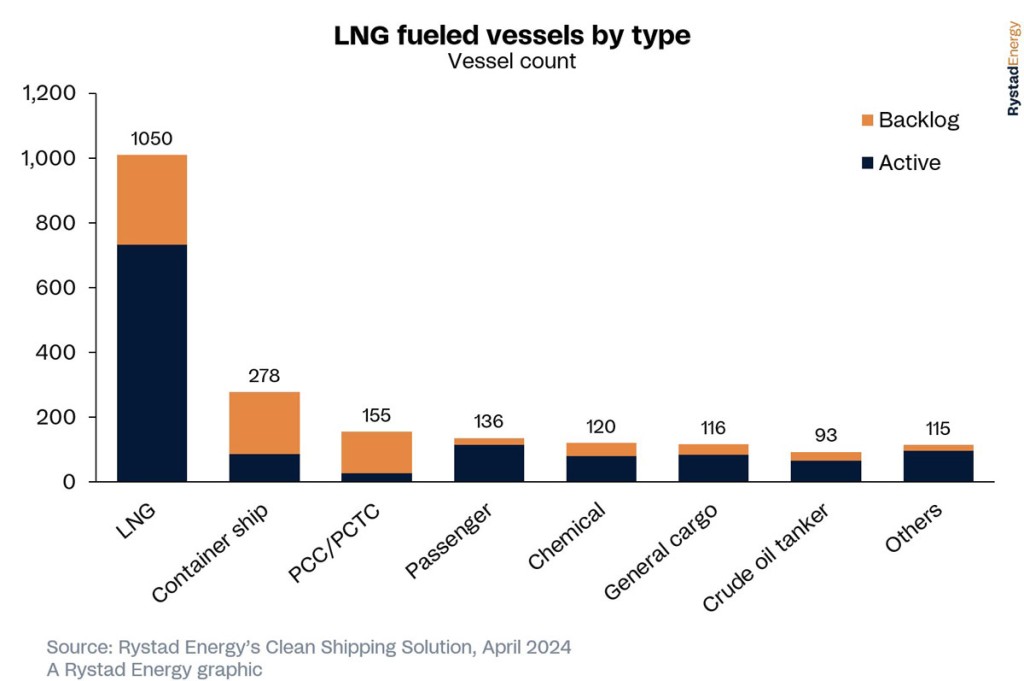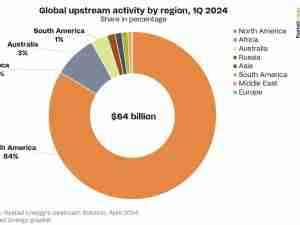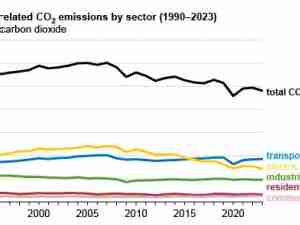Liquefied natural gas (LNG) remains the fuel of choice for lower-carbon shipping, despite the rise in orders for vessels equipped with dual-fuel methanol and ammonia engines, according to Rystad Energy analysis. While question marks remain around just how environmentally friendly LNG is as a shipping fuel, its price competitiveness, abundant supply, and well-developed infrastructure give it an advantage over the alternatives. This is particularly evident with LNG bunkering; fueling ships at ports with LNG.
More than 2,400 vessels are equipped to operate on LNG globally, with another 1,000 vessels ordered, yet to be delivered. It is worth noting that half of operational LNG-fueled vessels are carrying LNG from producers to customers. These ships use boil-off gas as fuel, reducing their reliance on external LNG bunkering. Even excluding LNG carriers, the fuel remains the most common choice for dual-fuel ships in the global fleet.
Car carriers have emerged as a significant driver of LNG adoption in the shipping industry, alongside container ships and LNG carriers. More than 75% of new car carrier orders in 2023 were for dual-fuel LNG engines. Many of these new ships can be adapted to use alternative clean fuels, such as ammonia or methanol, making them sustainable over the longer term.
Despite the growth in LNG-fueled fleets and bunkering, methane slip (gaseous methane emissions) is still a significant challenge for the maritime sector. Methane slip occurs when unburned methane escapes into the atmosphere. It is a critical concern for the industry and needs to be addressed if the environmental benefits of LNG are to be fully realized.
“Methane slip can occur not only during the combustion process in ship engines but also during the bunkering process. This is heavily influenced by the quality of infrastructure and the efficiency of the technology employed. The industry must work closely with regulators and policymakers to establish strict standards and best practices for bunkering operations. Implementing effective monitoring and reporting mechanisms to track and mitigate methane emissions across the supply chain is paramount.” says Junlin Yu, Senior Analyst at Rystad Energy.

LNG bunkering showing no signs of a slowdown
LNG bunkering is usually done via three main methods: truck-to-ship (TTS), pipeline-to-ship (PTS) and ship-to-ship (STS). In 2023, LNG bunkering hit a record high with 4.7 million cubic meters delivered globally, up 62% compared to 2022. This surge was primarily driven by a strong uptick in STS deliveries which doubled in 2022.
Several factors are fueling the surge in LNG bunkering demand, including stricter regulations, economic benefits and expanding infrastructure. Based on data for the end of March, LNG bunkering sales in 2024 are off to a strong start, with 1.9 million cubic meters already sold. This is close to the total volume sold in 2022, suggesting the potential for a significant increase by year-end. If so, total LNG bunker sales could surpass 7 million cubic meters by end-2024, highlighting the importance of LNG to maritime business and trade.
Burgeoning activity represents promising growth for LNG bunkering in 2024 with the growing number of LNG-powered vessels in the global fleet, attractive pricing relative to conventional marine fuels such as very low-sulfur fuel oil (VLSFO) and the continued push for cleaner fuel alternatives from various regulatory bodies expected to drive further growth.
" src="cid:[email protected]" alt="image003.jpg" border="0" class="Apple-web-attachment Apple-edge-to-edge-visual-media Singleton" style="width: 6.9791in; height: 4.75in; opacity: 1;">
Ship-to-ship (STS) operations clearly favored
Despite a significant surge in LNG prices in 2022, STS transfers accounted for 2.9 million cubic meters, driven primarily by a strong uptick in STS deliveries in Europe and other markets such as mainland China. By contrast, PTS and TTS volumes maintained modest year-on-year growth in 2022, with these modes continuing to serve critical segments such as passenger and roll-on-roll-off (Ro-Ro) vessels.
STS bunkering is expected to accelerate, particularly in Europe, given its position as a major maritime hub with 85 LNG bunkering ports and the fact that a rising number of ports are offering STS capabilities. In Asia, 26 ports offer LNG bunkering, led by China, Japan and South Korea. While LNG bunkering facilities exist in Africa and South America, these regions have not yet seen significant activity.
Ro-Ro/passenger vessels and container ships have consistently held the top two positions in STS LNG bunkering. In 2023, passenger vessels saw 632 STS LNG bunker operations, closely followed by containerships with 201 operations. This dominance can be attributed to their regular refueling needs and the growing presence of LNG-powered vessels within their fleets. For example, in 2023, a Ro-Ro/passenger vessel operating between Finland and Sweden led with 240 bunkering events.

_-_28de80_-_939128c573a41e7660e286f3686f2a6e25686350_yes.jpg)







